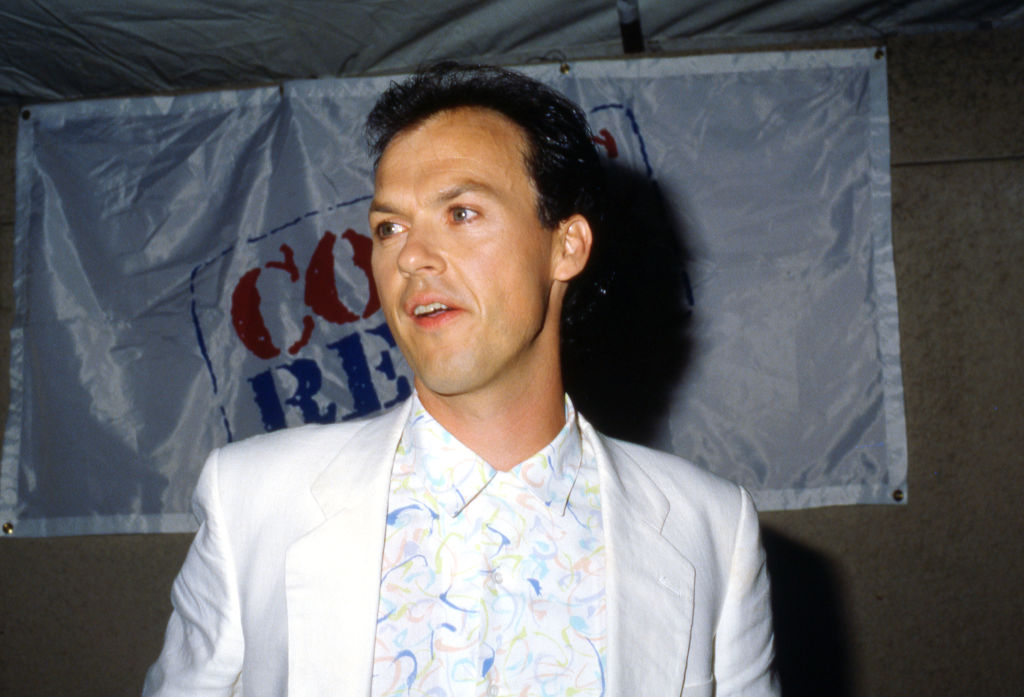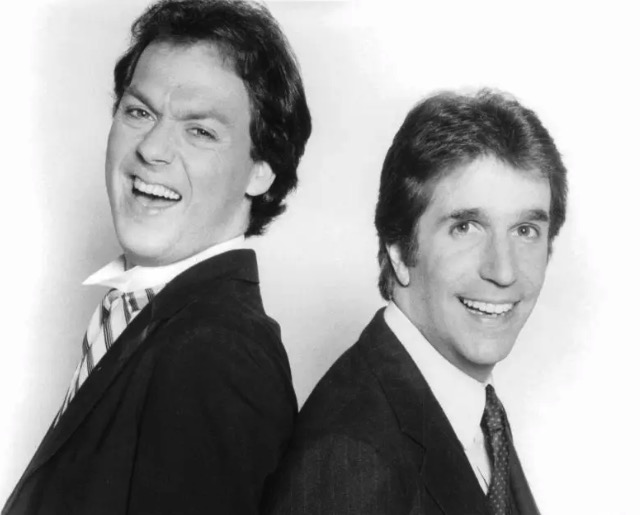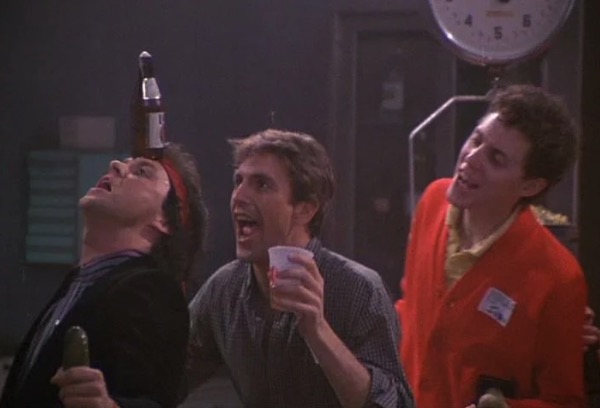
What happens when you mix the cool charisma of Henry Winkler with the wild, scene-stealing energy of Michael Keaton? You get nothing less than comedic brilliance!
Night Shift (1982) wasn’t just Ron Howard’s directorial debut — it marked the start of a cult classic. Winkler and Keaton’s electric chemistry lights up the screen, Shelley Long adds her irresistible charm, and if you look closely, you might even spot a young Kevin Costner in the middle of all the chaos…
But the real standout? Shelley Long’s unforgettable “magic in the kitchen” moment. Ready to uncover the secrets behind this iconic film? Let’s dive in!
From Morgue to Mayhem
Released in 1982, Night Shift is a quirky comedy that introduced audiences to Michael Keaton’s unforgettable charm while showcasing Ron Howard’s growing directorial skill.
Set in a New York City morgue, the film follows Chuck Lumley (Henry Winkler), a mild-mannered night-shift worker, and Bill Blazejowski (Michael Keaton), his eccentric, wildly ambitious new coworker. The pair stumbles upon an unconventional business opportunity — turning the morgue into a base for a high-end escort service. What follows are a series of hilarious, unpredictable situations.
What makes this movie stand out is not only the clever humor but the remarkable chemistry between the three leads. Each character is incredibly likable, making it all the more fun to watch.
Callbacks and Keaton’s Breakthrough

It’s impossible to talk about Night Shift without mentioning Michael Keaton.
Although Keaton was relatively unknown at the time — having only appeared in a B-comedy and a CBS series Report to Murphy — Night Shift marked his big break. His performance as Bill “Blaze” Blazejowski catapulted him to stardom. Keaton’s fast-talking style, goofy charm, and infectious energy brought the character to life, but it took a series of callbacks before he finally landed the role.
“I don’t know how many times I had to go back in and audition,” Keaton recalled. “It was just callback after callback after callback.”
When he finally got the part, Keaton transformed into a whirlwind of energy, channeling a style that would become his trademark.
“I came along just as the transition from TV actors to film actors was happening,” Keaton said, reflecting on the moment his career took off.
To really get into the groove of his character, Keaton would blast Bruce Springsteen’s “10th Avenue Freeze-Out” from the Born to Run album.
The Man Who Helped Keaton Shine

Ron Howard struck gold when he cast Michael Keaton for Night Shift.
Time after time, Keaton outshone his co-star Henry Winkler, who was already a TV legend for his role as “The Fonz.” Critics raved about Keaton’s performance, and Hollywood took notice. But Keaton’s success might not have happened without Winkler’s understated yet vital support.
“Henry was offered either part and chose the quieter role,” Ron Howard revealed in an interview with the Boston Globe. “Then he helped Michael steal the show. Henry gave Michael a lot of room to make his performance shine. Some of the bits, Henry would suggest, ‘I know this will get a laugh if you take it one step further.’”
Winkler, who had made his name playing the confident Fonzie, chose to play Chuck Lumley, a timid morgue director, as a deliberate contrast to his tough-guy persona. As he jokingly put it on Twitter: “I thought I’d play Richie Cunningham for once.”
A Tense Beginning

Interestingly, the dynamic between Keaton and Winkler didn’t come without tension. Their on-screen chemistry was undeniable, but behind the scenes, their relationship was a bit rocky at first. Winkler wasn’t initially sure about working with Keaton. “The guy’s talented, but I don’t know if I’m comfortable working with him,” Winkler recalled.
Ron Howard reassured him that the discomfort was actually beneficial — it mirrored the awkward dynamic between their characters. As the film progressed, their unease faded, making their on-screen relationship all the more authentic.
Big Names Who Almost Landed the Role
It’s hard to imagine anyone other than Michael Keaton as Bill Blazejowski, but several big names almost landed the role. Kurt Russell, Mickey Rourke, John Belushi, Dan Aykroyd, Bill Murray, and even John Candy were all considered, but none were interested.
It was writer Lowell Ganz who had seen Keaton’s potential and convinced Ron Howard to cast him. “Keaton is going to be a star for somebody, and he might as well be a star for us,” Ganz said.
Improvised Brilliance
Throughout Night Shift, Michael Keaton’s improvisational genius shines through. One standout moment happens when a blind man asks for spare change. Keaton’s response? He writes the guy a check. Classic Keaton!
Ron Howard’s Cameos
As expected, Ron Howard made sure to include a few cameos in his directorial debut. Look closely, and you’ll spot Ron and his wife Cheryl sharing a kiss outside Chuck’s apartment. Additionally, in a fun subway scene, Ron Howard himself plays an annoying saxophonist. Of course, his brother Clint Howard also makes an appearance as Jeffrey, the quirky character in the morgue.
A Young Kevin Costner

The film is packed with early appearances from future stars. Kevin Costner makes a blink-and-you-miss-it cameo as a frat boy at the morgue party, where he’s just hanging out in a checkered shirt and a college cardigan, while Keaton balances a bottle on his head.
Shannen Doherty also makes her film debut as a “Blue Bell” (a Girl Scout-like character) in an elevator scene, delivering a single line. These brief moments add some extra fun to this quirky classic.
The Birthplace of a Hit Song
Did you know Night Shift was the first place we heard the iconic tune “That’s What Friends Are For”? Originally recorded by Rod Stewart for the movie’s 1982 soundtrack, it went on to become a global hit in 1986 when Dionne Warwick, Elton John, Gladys Knight, and Stevie Wonder collaborated on a version that topped the charts and raised millions for AIDS research.
Meanwhile, the film’s soundtrack features catchy tunes like Quarterflash’s Night Shift theme and classic tracks by Van Halen and the Rolling Stones.
Shelley Long’s Hesitation

Shelley Long plays Belinda, a tough yet sweet prostitute who teams up with Chuck and Bill. Initially, Long was hesitant about playing a prostitute but did her research and ultimately accepted the role. “She came to us dressed like a hooker, and she was terrific,” Ron Howard said.
Her portrayal was praised as “the happiest, most wholesome hooker you’ll ever see on screen,” with critics even joking she could lead a Girl Scout troop!
The Classic Egg Scene
One of the funniest moments in Night Shift is when Shelley Long’s character makes breakfast for Chuck while wearing only her underwear. When Chuck asks for scrambled eggs, Long’s character makes fried eggs, yet when she serves them, they’re scrambled! It’s a hilarious goof that perfectly captures the film’s quirky humor.
The Subway Mistake
Though much of Night Shift was filmed in New York, the morgue was actually a set in Hollywood. In one subway scene, there’s a mistake where Bill gets off the train at a stop that the train doesn’t actually make — a small but noticeable error for eagle-eyed viewers!
A Timeless Comedy
Night Shift isn’t just a comedy — it’s a story of unlikely friendships, personal growth, and finding connection in the most unexpected places. The chemistry between Henry Winkler, Shelley Long, and Michael Keaton is pure magic, bringing humor and heart to an unforgettable film.
What’s your favorite moment from this 80s classic? Share it with friends and take a nostalgic trip back to one of the funniest films of its time!
Lucky Colors for the 12 Zodiac Signs
Each zodiac sign has certain colors that can enhance positive energy, attract good fortune, and increase confidence. Here are the lucky colors for each zodiac sign:
♈ Aries (March 21 – April 19)
🔥 Lucky Colors: Red, Orange, Scarlet
🔺 Why? These vibrant and fiery hues amplify Aries’ passion, confidence, and natural leadership.
♉ Taurus (April 20 – May 20)
🌿 Lucky Colors: Green, Pink, Earthy Tones
🔺 Why? Green symbolizes growth and stability, while pink nurtures love and harmony.
♊ Gemini (May 21 – June 20)
💛 Lucky Colors: Yellow, Light Green, White
🔺 Why? These colors enhance Gemini’s communication skills, creativity, and flexibility.
♋ Cancer (June 21 – July 22)
🌊 Lucky Colors: Silver, White, Light Blue
🔺 Why? These calming colors mirror Cancer’s emotional depth, intuition, and lunar connection.
♌ Leo (July 23 – August 22)
☀️ Lucky Colors: Gold, Orange, Yellow
🔺 Why? These warm, royal colors reflect Leo’s charisma, confidence, and inner strength.
♍ Virgo (August 23 – September 22)
🌾 Lucky Colors: Green, Brown, Beige
🔺 Why? Earthy tones support Virgo’s practicality, wisdom, and love for order.
♎ Libra (September 23 – October 22)
🎀 Lucky Colors: Pink, Blue, Pastel Shades
🔺 Why? These soothing colors promote Libra’s sense of balance, love, and diplomatic nature.
♏ Scorpio (October 23 – November 21)
🖤 Lucky Colors: Black, Dark Red, Burgundy
🔺 Why? These intense, deep colors represent Scorpio’s mystery, passion, and transformational power.
♐ Sagittarius (November 22 – December 21)
💜 Lucky Colors: Purple, Royal Blue, Dark Yellow
🔺 Why? These bold colors reflect Sagittarius’ adventurous spirit, optimism, and philosophical outlook.
♑ Capricorn (December 22 – January 19)
🖤 Lucky Colors: Black, Gray, Dark Green
🔺 Why? These colors embody Capricorn’s disciplined, ambitious, and grounded energy.
♒ Aquarius (January 20 – February 18)
🔵 Lucky Colors: Blue, Electric Blue, Silver
🔺 Why? These futuristic colors enhance Aquarius’ innovative, original, and forward-thinking nature.
♓ Pisces (February 19 – March 20)
🌊 Lucky Colors: Sea Green, Lavender, Aqua
🔺 Why? These calming and dreamy hues boost Pisces’ creativity, intuition, and emotional insight.
Wearing or incorporating these lucky colors into your surroundings can attract positive energy and bring success! 😊✨